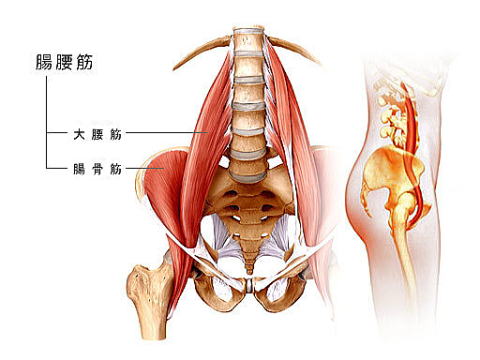腸腰筋は、人間の歩行や走行に最も重要な役割を担っている骨格筋と言われています。骨盤内に付着し、半身と下半身を接続する唯一の筋肉でもあり、身体の重心に位置し、バランスを調整したり、神経や微細なエネルギーに影響を及ぼします。下腹部の血流と深く関連しており、腸腰筋が固くなって血流を阻害すると、便秘や消火不良、むくみ、生理不順などの症状にあらわれます。骨盤内の血流が良くなると、代謝が上がり、脂肪を燃焼しやすくなります。腸腰筋の存在を意識し目覚めさせることで、普段とは違う身体の感覚を体感できるでしょう。
腸腰筋は、腸骨筋と大腰筋、小腰筋という3つの筋から成り、総称して腸腰筋と呼ばれています。腸腰筋は腸骨という骨盤を構成し、お尻の形を作る骨に始まります。腸骨筋はその骨の内側上部から、大髄骨の小転子という突起に付着します。股関節を曲げる働きと、骨盤の前後の傾きにかかわってきます。大腰筋は深頭と浅頭の二つの付着部があります。大腰筋の浅頭は胸椎から腰椎に始まり、大髄骨の小転子に付着しています。大腰筋の深頭は腰椎の大部分、小転子に付着しています。小腸筋は大腰筋朝頭に沿うように付着し、腸骨と恥骨の結合部に付着します。


長時間のデスクワークにより、大腰筋が縮んで固くなってしまうと、腰椎の自然なカーブが失われ、腰を痛めてしまいかねません。


腸腰筋を意識できるようになると、
- 中心のバランスが意識しやすくなる。
- 臓器と神経が刺激される。
- 上半身と下半身のつながりを体感できる。
- 筋肉が収縮し、リリースし、安定し、中和し、衰えたりと活性化される。
- 身体全体を通じて伝達される動きと流れを生み出す。などの効果が見られます。
背骨同様に、腰筋は身体全体に影響を及ぼします。腸腰筋を健常で順応性の高いものにするために、柔軟で弾力があり活力のある状態にすることが大切です。どのようなことができるでしょうか。
- 腸腰筋を休める。
堅くて平坦な場所で仰向けになります。足の裏を床につけて、膝をまげて、腰幅に広げます。頭は背骨と一直線になるようにし、膝を少し体の内側に回旋させて、両膝をお互いに寄りかからせて、手は腕を組んで胸において、心地いい状態でリラックスします。股関節の緊張を休めます。
- 骨盤を動かす。
立ち上がって、骨盤を前と後ろ、横の上下、水平面に動かし、骨盤が自由に柔軟に動けるように、周りの筋肉の緊張をほぐします。
- 仙腸関節、骨盤のお尻の筋肉の可動域をあげる。
仙骨と腸骨の関節を意識して、スクワットやスパイナルツイスト、身体を柔らかくひねりながら、お尻の緊張を緩めてみます。身体をツイストしてみたり、上下に思い切り伸びをしたり、身体のサイドストレッチはとても効果的です。
ジャイロキネシス、ジャイロトニックのエクササイズ共に、大腰筋に働きかけ、身体が記憶できるような振付けが沢山あります。
参考文献:『目醒める!大腰筋』著:Jo Ann Stauggard-Jonesの中で印象に残ったのは、腸腰筋を揺らしてみるというアプローチです。胎児の姿勢やうつ伏せになって、動いて、止まったり、赤ちゃんの骨盤の振動や揺さぶりを想像してみます。下肢から脊椎までの筋肉経路(筋膜、腱、神経分布)を思い浮かべ、真似してみます。子供の時、物事をどう観て、どう感じていたかを思い出し、判断せずに、まったく初めてかのように自分の身体の内側を観察してみたり、新しい可能性を受け入れます。時間はかかりますが、習慣にとらわれることなく、筋肉も思考も同じように、体の英知を使用することが可能というアプローチです。

“The psoas is considered a core muscle that acts as a keystone, central and superior to the flying buttresses of the femurs and thigh muscles. This major architectural concept is also apparent in the skeletal pelvis / leg relationships, and supports the human body much like an arch does in bulding structures.
The psoas travels vertically from the spine to the leg, and diagonally across the pelvis. As a skeletal muscle that passes across more than one joint, it becomes bi-articulate ( a muscle that works two joints). This is a most important concept, but it is interesting to note another role of the psoas : a shelf, supporting internal organs, along with the pelvis as a basin, and the pelvic floor. Thus, any force of teh psoas can stimulate and massage organs such as the intestines, kidneys, livers, spleen, pancreas, bladder, and or stomach. Even reproductive organs are affected. Some deep, central, internal organs are referred to as viscera, so communication from organs to the brain can be called visceral massaging. The psoas, because of its proximity to major organs, can play a role as a reactor to these stimuli, affecting what is commonly termed gut feelings.
It can also affect nerve innervation, especially the lumber nerve complex that passes through it. The aorta lies in a similar path to the psoas, so body circulation and rythms can be interwined with the psoas as well. Another remrakable fact is that psoas and the diaphragm, a major breathing muscle, come together at a junction point known as the solar plexus. No wonder the psoas is so special. The psoas can:
- Balance the core.
- Stimulate organs and nerves.
- contract, release, stabilize, neutralize, or deteriorate like any other muscles.
- connect the upper body to the lower body.
- create movement and flow to be transmitted throughout the body.
- affects the whole person.”
Reference : “The vital psoas muscle- Connecting Pysical, Emotional, and Spiritual Well-being.” by Jo Ann Stauggard- Jones
